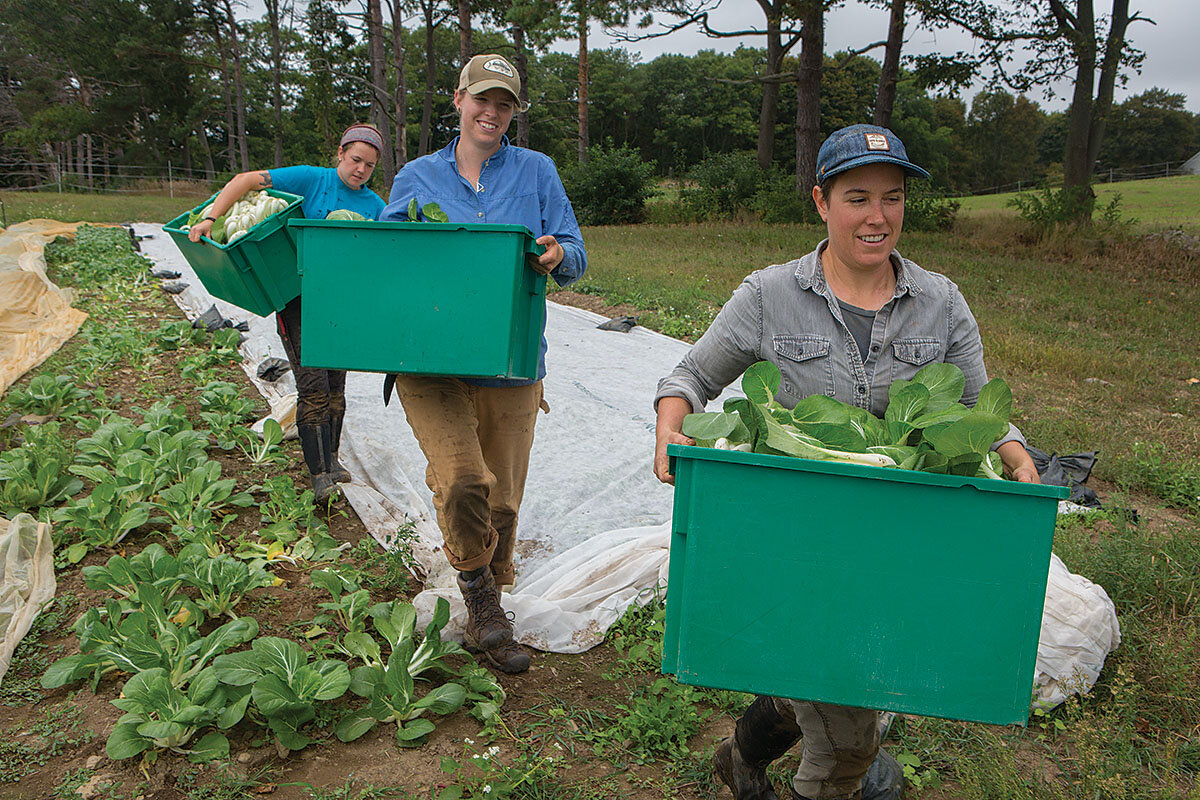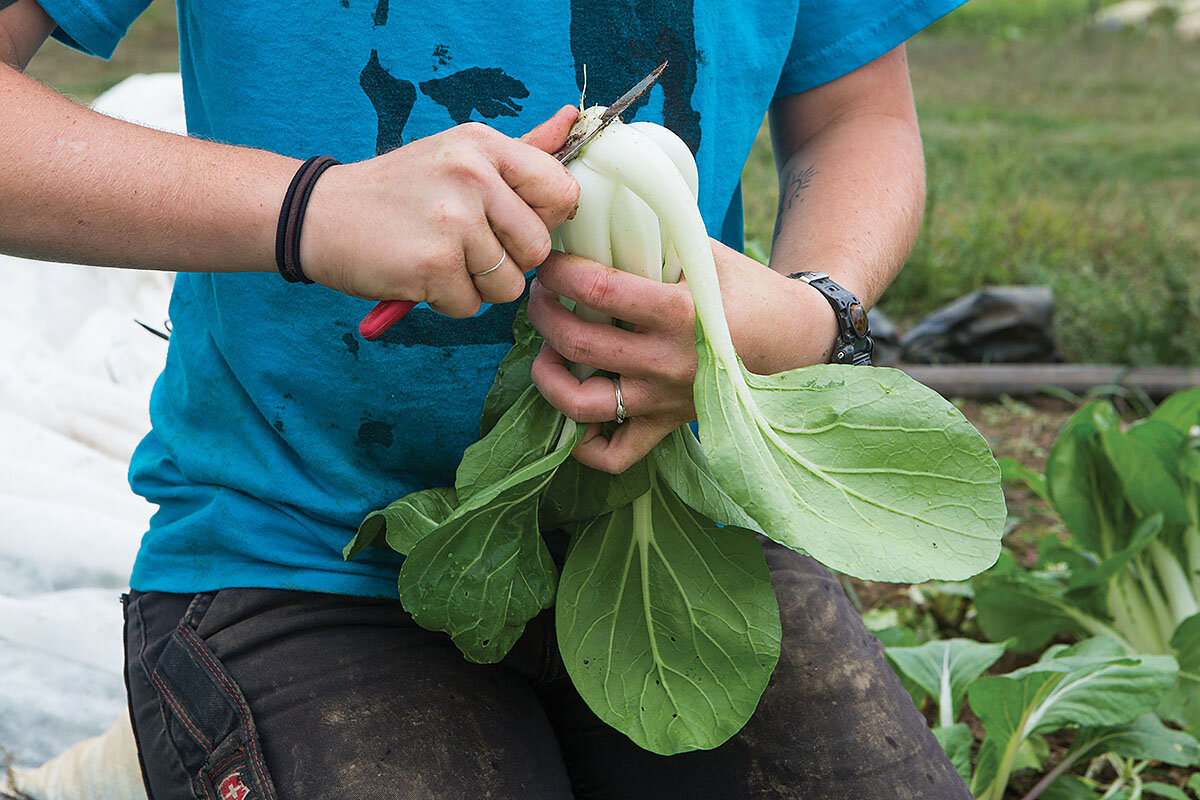Women take the tractor wheel
Loading...
| Brookline, Mass.
Kate Stillman starts her day at 4 a.m. Four days a week, the third-generation farmer loads up a truck the size of a small U-Haul and drives 75 miles from Hardwick, Mass., to farmers markets across the Boston area. The truck is so weighed down by her cuts of locally raised meat and produce grown by her father and brother that the bumper barely clears the curb. If there is room in the cab, one of her two young boys will ride along with her.
She’s used to not sleeping much.
“When you have animals – like when you have small children – it’s the same thing. You never really sleep soundly. You are constantly trying to listen for if there is a problem,” says Ms. Stillman, who sells grass-fed beef, lamb, pastured poultry, and pork from animals she raises on a farm that she bought in her early 20s. She’s also a single mother. Midnight is the earliest she turns in.
With her right arm thrust deep inside a glass-topped freezer as she rummages for a customer’s order at the Brookline Farmers Market, Stillman recounts the time she forgot to pick up her 5-year-old son from day care. Two days before Thanksgiving, she was in the middle of processing hundreds of turkeys when she glanced at the clock. It was 8:30 p.m. A call to her stepmother eased her worries – he was with her, brushing his teeth and getting ready for bed. She feels fortunate to have a large, supportive family.
“When I work the farmers market, I wish this was my only job and I could go home at night and cook and eat with my kids and take a normal vacation,” says Stillman. “But that’s OK. I wouldn’t trade it. I think this is the best lifestyle for me, and my kids think it is kind of magical that they are growing up on the farm. They put up with the schedule and the work.”
Hard work has always defined farming. And many say it’s only going to get harder as farms are squeezed by rising land and labor prices, falling commodity prices, and an aging demographic – the average US farmer is 58 years old. Analysts warn of a potential farm crisis not unlike the one seen during the Great Depression.
But small-scale farming, which takes place on 90 percent of the farms in the United States, continues to thrive. These farms are figuring out the formula of diversifying their income streams through farmers markets, agritourism, and cottage industry products, resisting the call to “get big or get out.” And in some areas of the country, it is a rising number of women like Stillman who are taking the wheel of the tractor.
Nearly 1 million women work on US farms, and nearly 290,000 head up farm operations, according to the US Department of Agriculture (USDA).
Across New England and the Pacific Northwest, the 2012 Census of Agriculture showed a higher concentration of women farmers than did other regions. In addition, across 16 states the number of female principal operators had increased since 2007.
Some women are coming to farming midlife as a second career. Others are young visionaries equipped with degrees in environmental science and a passion for reimagining the food system. Still others grew up on a family farm but fled – vowing to never lift another shovel of manure – only to have a change of heart. Armed with high-speed internet connections, they are marketing rural life with networking potlucks, farm stays in Airstream trailers, and nostalgia-inducing Instagram streams.
“It’s the size of the farms; they are more manageable,” says Helen Brody, coauthor of “New Hampshire Women Farmers: Pioneers of the Local Food Movement,” as to why the growth is concentrated in the New England and the Pacific Northwest. “I think [women find] it more comfortable to have small farms.... Women are natural nurturers – and that’s why they were such good marketers at farmers markets: They like the idea of being able to provide healthy, good food for their families and talk about it.”
More than the ‘farm wife’
While women have been working on American farms since Colonial times, they’ve often been depicted as the “farm wife,” the silent partner to the “farmer” who was credited with tending to the fields and the livestock.
Before 2002, the USDA tracked the gender and age of only principal farmers – who are predominantly men. As a result, the contribution of women and other minority groups on US farms went underreported.
“Women have been living on farms for centuries in this country and they have been very involved in the farms, but ... their roles have been downplayed,” says Carolyn Sachs, a professor of rural sociology at Penn State College of Agricultural Sciences and author of “The Rise of Women Farmers and Sustainable Agriculture.”
“And it’s not just by others,” she adds. “Women will minimize their own involvement also because the man is the farmer and they don’t want to take away from his status.”
Denise O’Brien didn’t grow up on a farm, but she ended up marrying Larry Harris, a man who did. They were young and idealistic in the 1970s, inspired by activism around Earth Day, the Vietnam War, and the women’s movement. With his parents’ blessing, they started organic farming in the ’70s. They’ve been operating Rolling Acres Farm near Atlantic, Iowa, ever since.
When the farm crisis hit Iowa in the ’80s, Ms. O’Brien and her husband joined the community meetings where farmers were sharing ideas about how to survive.
“Women would come up to me in meetings and say, ‘You call yourself a farmer?’ And I’d say, ‘Yes, I do.’... And they’d say, ‘Well, I’m a farmer’s wife.’ And so I’d say, ‘What do you do?’ And they’d list all the chores and I’d say, ‘Well, that sounds like a farmer to me.’ ”
In 1993, she became president of the National Family Farm Coalition. That same year, she read a study finding that women owned close to 50 percent of the farmland in Iowa.
“Basically women were not identified with farming and agriculture, only as farmers’ wives, yet they were a critical economic piece of the family farm,” says O’Brien. So she started calling them together for informal meetings, eventually getting funding from the USDA.
By 1997, she had founded the Women, Food and Agriculture Network. Today, WFAN claims more than 10,000 women in its network representing all 50 states and parts of Canada.
Despite strong networks and USDA funding for beginning farmers, women continue to face sexism when it comes to being accepted as an agricultural peer.
Stillman, who comes from a farming family and who secured her first loan to buy her farm with her ex-husband before she was 30, still fumes when she remembers trying to get a loan from her local bank to build a slaughterhouse. It was necessary for her survival: The large industrial processing plant she used kept losing her meat.
“[The application] wasn’t coming together ... and it kept dragging on, and my banker said to me, ‘Why don’t you just go home and bake some cookies or something?’ I was so livid,” recalls Stillman. “My brother who is a farmer has never been through that.”
In the end, she got the loan and built the slaughterhouse.
“All of us [women farmers] have a million horror stories of people talking to us like we are dummies, especially about equipment,” says Elizabeth Green, a Boston-area farmer in her mid-30s who built Three Sisters Garden Project from the roots up. “There is just a lack of understanding that a woman could run a big business and be excellent at it.”
Three Sisters is a vegetable farm in Ipswich, Mass., run as a nonprofit that leases its land from an order of Roman Catholic nuns. Now in its third year, it supplies 130 farm shares to the surrounding area, and offers educational programs and training for new farmers.
Ms. Green chose all the equipment, erected the greenhouse, added a walk-in cooler, and put in a well.
She learned how to drive a tractor from a woman farmer in Belmont, Mass. But she says there are still some farms in New England that won’t let women on tractors.
“A lot of us in my generation are looking for meaningful work that connects to our values, and sometimes the long-haul, big-picture advocacy work that I was doing was hard because you don’t see results for a long, long, time,” says Green, who now oversees three farms for The Trustees of Reservations. “But with [farming], I can put in a day’s work and I can literally see ... the fruits of my labor, which is an incredible feeling.”
Women farmers have a tendency to reach out to other women farmers, researchers like Professor Sachs have noted.
“When I started [farming], it was easy to quickly feel isolated ... but from the get-go, it was the other women farmers and women I met ... who were amazing sources of support,” says Lisa Kivirist, who runs an ecofarm and bed-and-breakfast operation in Wisconsin’s dairyland with her husband. She’s also the author of “Soil Sisters: A Toolkit for Women Farmers.” “As I moved along in my learning, it has always been a passion of mine to continue that connection and really grow that collaborative spirit we have.”
Workshops in Wisconsin
One of those ways is through a series of workshops and farm tours she helped develop: “Soil Sisters: A Celebration of Wisconsin Farms & Rural Life.” For the past five years, more than 20 women farmers have collaborated to open their farms with down-home activities such as cheesemaking, fermentation, and workshops on how to start a business out of one’s kitchen.
On an unusually chilly August morning, attendees of the “In Her Boots” workshop perch on hay bales inside the hoop house at Kriss Marion’s Circle M Farm in Blanchardville, Wis., as a few orange barn cats circle and rub up against their ankles.
Etienne White describes her first Soil Sisters weekend two years ago as “three days of sheer inspiration.” In addition to a wealth of information, she took away an unexpected bonus: a pair of old barn boots that Ms. Marion was getting ready to toss. This year Ms. White, now a fledgling farmer, offered to help with “In Her Boots” – literally wearing Marion’s boots.
Marion, who runs Circle M Farm with her family, addresses the crowd like a tent revival preacher. Her converted Airstream trailer, which sleeps four and is parked on the side lawn, has been a surprise success. The first guests were from France, she says, and it was fully booked almost immediately.
“We thought, what are people doing out here in Blanchardville? Why are they here? Well, it turns out they’re here because of us,” says Marion as the women nod and take notes. “Don’t underestimate the importance of just a small green space that you’re taking care of,” she says. “People want to get in touch with that.”
Marketing farm life may just be the secret sauce that helps small-scale farms survive. Stillman cites a couple of her favorite women farmers on Instagram, such as Floret Flower (with 469,000 followers).
“My father is so great at driving a tractor, but you are never going to find him [Instagramming],” says Stillman. “These women are the faces of the farms, and they are totally blowing the top off of what farming is and I’m in awe.... They have completely changed the boundaries of their farms.”
Staff writer Gretel Kauffman contributed to this report from Blanchardville, Wis.








